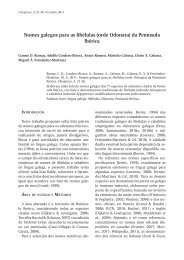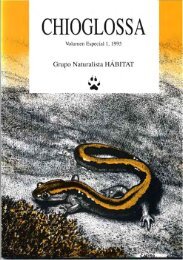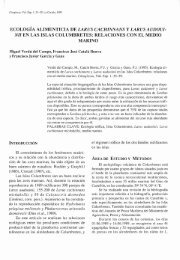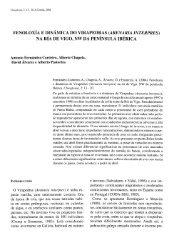1 Tr - Chioglossa
1 Tr - Chioglossa
1 Tr - Chioglossa
Create successful ePaper yourself
Turn your PDF publications into a flip-book with our unique Google optimized e-Paper software.
112<br />
que explotan los bancos de semillas, que constituyen<br />
el recurso trófico dominante en estos<br />
medios durante el invierno (p. ej., Tellería y Santos,<br />
1985; Tellería el al., 1992).<br />
Muchos de los trabajos de restauración de<br />
terrenos afectados se han orientado hacia el<br />
mantenimiento de una cubierta herbácea con<br />
apariencia de "pradera", eliminándose las especies<br />
de matorrales colonizadoras por motivos<br />
"estéticos" (I.T.G.E., 1989). El manejo posterior<br />
de estos terrenos suele incluir la plantación de<br />
especies arbóreas, a menudo ornamentales y frecuentemente<br />
exóticas, las cuales, a causa del<br />
deficiente sustrato edáfico, suelen mostrar un<br />
escaso desarrollo y una elevada mortalidad (Gil<br />
Bueno, 1994). Tales manejos posteriores generalmente<br />
incrementan los costes de la restauración<br />
y resultan ineficaces.<br />
Si los trabajos de rehabilitación de zonas afectadas<br />
por actividades extractivas (o incluso de<br />
otras áreas que han sufrido impactos similares,<br />
como los desmontes y taludes de los grandes<br />
viales de comunicación) se orientan hacia la<br />
recuperación de los hábitats naturales y a que<br />
éstos sean ocupados de nuevo por las comunidades<br />
animales que habían sido eliminadas, será<br />
decisivo el que se favorezca el proceso de la<br />
sucesión natural de la vegetación. Sólo ésta<br />
garantizará el desarrollo de los procesos de edafogénesis<br />
que permitan la instauración de una<br />
vegetación diversificada (Bradshaw, 1983;<br />
Brenner el al., 1983; Guitián Ojea, 1995) y, en<br />
último término, el que la diversidad animal<br />
retorne a los valores que tenía antes del impacto.<br />
SUMMARY<br />
Colonizalion of spoil henches of an opencasl lignile<br />
mine in northwest Spain h.,>, bird communities<br />
Colonization by birds of the spoil benches of the Meirama<br />
opencast lignite mine in northwest Spain was<br />
studied over the 1I years following the start of the<br />
revegetation process. At Meirama, spoil benches are<br />
initially fertilized and hydroseeded with apasture<br />
mix, but are subject to little subsequent management<br />
CHIOGLOSSA. 1 (1996)<br />
and are gradually colonized by scrub vegetation characteristic<br />
of the region. Bird censuses were carried<br />
out in May (reproductive season) and in December<br />
(winter season) of 1995 on six plots on spoil benches<br />
ranging in age from Oto 1I years. Bird recolonization<br />
is particularly rapid after the first 2 - 3 years posthydroseeding,<br />
and is clearly closely related to habitat<br />
development due to revegetation and natural succession.<br />
The establishment of bird communities on Meirama<br />
mine spoils is typically dependent on the establishment<br />
of native plant communities. The pioneer<br />
colonists identified are typical grassland bird species<br />
(1 - 3 years post-hydroseeding). Following colonization<br />
by these pioneer species other bird species only<br />
appeared when the scrub layer was well developed<br />
(from the fourth year onward). Some species (such as<br />
typically woodland bird species) were not detected<br />
until the 7 - II years post-hydroseeding, by which<br />
time the vegetation cover tends to be a dense scrub<br />
with relatively high plant species diversity (from 7 <br />
10 years onward) 01' tree communities dominated by<br />
Alnus, Salix and Betula develop along the bank of a<br />
larger drainage ditch (from the eleven year onward).<br />
Bird species composition was relatively similar to<br />
that in natural surrounding areas in the oldest (seven<br />
to ten-year-olds) spoil plots.<br />
Key words: colonization, disturbed land, opencast<br />
mining, restoration, revegetation, spoil benches, succesion.<br />
BIBLIOGRAFÍA<br />
Arnold. G. W. (1983). The influence of ditch and<br />
hedgerow structure, length of hedgerows, and<br />
area of woodland and garden on bird numbers on<br />
farmland. J. App/. Eco/., 20: 731-750.<br />
Bejcek, V. (1988). Communities of small terrestrial<br />
mammals on the spoil hanks in the Most Basin.<br />
Yysoká Skola Zemedelská, Praha.<br />
Bejcek. V. Y Stastny, K. (1982). Sucession uf hird<br />
communilies 0/1 spoi/ hanks after surface hrown<br />
coal mining. XVIII Congressus Internationalis<br />
Ornithologicus, págs. 166-167. Moscow.<br />
Bejcek, Y. y Tyrner, P. (1980). Primary sucession and<br />
species diversity of avian communities on spoil<br />
banks after surface mining of lignite in the Most<br />
basin (NW Bohemia). Folia Zool., 29: 67-77.<br />
Blanco, M. D., Casas, A., Cives, J., Galán, P., Gil, F.,<br />
González, M. Y., Guitián, F., Leirós, M. c., Saá.








